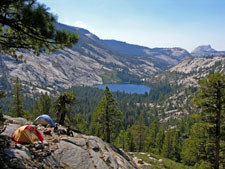Fishing Yosemite - And Yosemite's Fish...
how it was all made possible

At one time, fishing Yosemite was impossible.
Or at least catching fish was.
It just seems that in these surroundings with all of the beautiful water that there would be fish. But there weren’t.
Once you understand why, it all makes perfect sense.

Today as you visit the alpine lakes and streams of Yosemite National Park you will notice that nearly all of the waters are the home of some type of fish. And most all of the waters now contain various kinds of trout.
But this has not always been the case.
When ancient Pleistocene glaciers thousands of feet thick scoured their way through the major stream canyons of the Merced and Tuolumne Rivers, all fish life, (already frozen and dead), was ground completely out of existence.
Once the glaciers finally receded the aquatic life slowly began to return to the systems that were accessible to them. But now the high and free-leaping waterfalls that were left in the wake of the glacial action that formed them, prevented the fish from ascending into the high country headwaters where they could repopulate those high elevation sections of the rivers.
It appears that this is a fact verified perhaps by a letter on file in the Yosemite Museum library. The letter was written to Mr. Chester Versteeg on July 12, 1924 by Army Colonel H. C. Benson, one of Yosemite’s earliest park superintendents.
In his letter Colonel Benson reported that when the Army arrived in Yosemite Park, that there were no fish in the higher elevations of the Park.
This was not the case in the lower elevations where fish were able to come directly up the Merced River to Yosemite Valley. Fish had also been able to come up the south fork of the Merced into those lower elevations.
But the natural distribution of the fish in Yosemite National Park was very limited and the numbers of indigenous fish “types” throughout Yosemite were few.
Of the six native species that were representatives of four families of fish, it was thought that the rainbow trout and the Sacramento sucker were the only original native species within the park.
The smaller non-game Sacramento squawfish, hard-head, California roach, and the riffle sculpin are all known to be natives.
Introducing Exotic Game Fish To Yosemite
Not long after European immigrants first arrived in the Yosemite region, they began the difficult task of introducing exotic game fish.
Their early efforts were initiated in an attempt to establish these fish in the vast and barren waters. Later it was to supplement the fish population in areas that were now being heavily fished.
As is always the case in the introduction of exotics, some adapted readily while others passed quickly "out of the picture". Of all of these the rainbow trout is the best adapted to most parts of Yosemite.
Over the years of fish planting, a total of seven species of game fish have been introduced into the waters of Yosemite National Park...
They are the rainbow trout, golden trout, brook trout, brown trout, cutthroat
trout, the lesser known Dolly Varden
trout and the American grayling. (The grayling and the Dolly Varden have not
been seen in the park for many years).
Stocking The First Fish In Yosemite

In 1877, 13 years before the area we now know as Yosemite Park had been set aside, the first recorded plants of rainbow trout were made. They took place in the barren lakes of Kibbie, Eleanor, Vernon, and Laurel. These lakes are all located in the northwestern section of the park.
Three intrepid pioneer settlers whose last names were Kibbe, Parsons, and Smith, are credited with the first “formal” introductions.
It is also thought that some of the early
sheepherders may have caught and moved trout from streams where they were
already established. The imtent was bring the fish into waters more accessible to summer grazing areas.
These efforts continued as John L. Murphy planted trout in
Tenaya Lake in 1878. At about the same time, plants of eastern brook trout were
being made in the Lyell Fork of the Tuolumne River.
The oldest written record of trout planting in the Yosemite Valley itself, dates back to April 1, 1879, when Mr. M. A. Blade of Union City, Pennsylvania, wrote the following short reference in the Grand Register of the Cosmopolitan House:
"Came in with the Yosemite Fish Commissioners with 20 thousand young trout for the different streams of the Valley."
More rainbow trout were planted in Lake Eleanor in 1880 and for several years no further fish plantings were recorded.
Planting Fish In Yosemite's High Country
In the fall of 1892, Mr. W. H. Shebley of the California Fish Commission began his journey toward the Yosemite region. His trip originated from the old Sisson hatchery in Siskiyou County, (later to become known as the Mt. Shasta hatchery).
With him he had a shipment of cutthroat, eastern brook, and rainbow trout fingerlings to plant.
All earlier attempts to plant hatchery trout had failed because of the time it took for the little fish to make the long trip. The men were well aware that time was of the essence, and they took what measures they could to expedite their shipment.
- On this first successful official stocking by the state, the shipment of fish arrived at the station in Raymond by railroad.
- They were immediately sent onward to Wawona via stagecoaches furnished especially for this shipment by the Washburn brothers. In Wawona the fish would over-night in local streams.
- The shipment was on its way by Army ambulance wagon to
Mono Meadow at first light the following morning.
- At Mono Meadow the little fish were transferred to awaiting pack-mules for the final stretch of their journey.
At last they reached their final destinations, and were
planted in Ostrander and Merced Lakes and in Bridalveil Creek.
The Army Comes In To Administer Yosemite
Once Yosemite had been officially set aside as a National Park, a systematic stocking of the streams and lakes was begun.
During the early days while the Army had responsibility for the administration of the park, Superintendent Colonel H. C. Benson took a great interest in fish planting.
Benson personally covered many miles of trail while overseeing the stocking of lakes and streams previously devoid of fish life. Many remote streams are now populated with reproducing trout thanks in large part to the interest that Colonel Benson took in these early efforts.
THE FISH:
The rainbow trout was already a native of the park in the lower areas below the falls. It would now be introduced to the once barren back-country lakes and streams and would be regularly restocked in the heavily fished Merced River running through Yosemite Valley.
The brook trout, the beauty of eastern streams, was the next fish brought into the Sierra. It was first planted in 1892 in Alder and Bridalveil Creeks, as well as in Merced and Ostrander Lakes.The brook trout now has a definite place in the cold, high-country, spring-fed streams and lakes where conditions are more suitable for it than any other species.
The cutthroat trout was introduced into a few waters as early as 1892. This species has never become very well established in Yosemite.
Two forms of brown trout, (a popular European variety of game fish), have also been introduced into Yosemite. In 1897 the Loch Leven form was the first brown trout planted and was followed in 1905 by the German variety. Noted ichthyologist Dr. Carl L. Hubbs, concluded that the differences between these two forms of brown trout are now insufficient to separate them as different species. The different stocks long ago lost any difference in the identity that they may have once had through their own interbreeding.
The golden trout, which is actually a variety of rainbow trout, is thought by some to be "the world's most beautiful trout''. In Yosemite it was first placed into Adair Lake in 1919 where it did well. It has since become successfully established in other waters around the park.
At an early and unrecorded date, the Dolly Varden variety of trout was introduced into the Chain Lakes along the southern boundary of Yosemite. It is thought that it may have actually occurred in this area natively as a remnant left over from wide ice-age distributions. Catches of the Dolly Varden have not been reported in Yosemite in many years.
The American grayling belongs to the family Thymallidae. Its chief marks of distinction are the iridescent silvery gray color and an extremely long and high dorsal fin.
The grayling is native to the north central portion of the United States and was stocked in Grayling Lake in 1929, 1930, and 1933. Fish of 13 1/2 inches in length and a weight of three-fourths of a pound were once caught. Most of the fish had moved down into the stream below Grayling Lake where they first had been stocked.
The success of the early planting of graylings in Yosemite waters was only temporary. None have been reported in many years and investigations have failed to reveal graylings anywhere in the park.
All fish
stocking efforts within Yosemite were discontinued in 1991.

Today's Yosemite Fish Family
The large fish family of Salmonidae includes the important game fish of the North Temperate and Arctic Zones, the salmon, trout, and charrs.
These fish are active, carnivorous, cold-water varieties. They possess extremely fine scales and an additional small fleshy fin on the back over the tail known as the adipose fin.
A special public interest in this particular family of fish exists because of the extensive migrations of the salmon from the fresh water to the ocean. It is commonly known that upon reaching maturity the salmon will begin the long and one-way return to their “cradle streams” to spawn and then to die.
Certain strains of other trout and charrs also migrate to the ocean and return to the fresh water to spawn.Unlike the salmon, these fish will often spawn several times before they are done.
Yosemite’s trout are known as “resident forms” because they do not
migrate to the sea and limit their movements to restricted local areas within
their habitat.
Fishing Yosemite's Rainbow Trout

RAINBOW TROUT...Physical Characteristics: The rainbow trout is easily distinguished from other trout by the uniform tiny black spotting on its sides and back, plus the rose-colored band extending the body length along both sides.
As mentioned earlier, the rainbow trout is thought to be the only species of trout that is native to the waters of Yosemite National Park. All other types of trout have been introduced.
The rainbow trout was first found in the Merced and Tuolumne river systems below the waterfalls which effectively barred their upstream migration beyond the Yosemite and Hetch Hetch Valleys.
The most “game” of trout once hooked, a rainbow will often exhibit aerial acro- batics, leaping high into the air repeatedly.
It is an excellent "fly fish", readily striking at feathered lures from the early days of summer on, when streams and lakes have begun to lose their springtime water volume.
A delicate set of environmental conditions must be maintained to keep a trout in balance with its surroundings. Critical factors include the volume and temperature of water, food supply, pollution, predators, disease, shelter and suitable spawning areas.
Because of the rainbow trout’s survival record under various different conditions, and since it is the native fish species in Yosemite, emphasis in artificial propagation and planting was once placed upon it.
Rainbow trout spawn in the spring from March to June as temperatures begin to rise. The timing depends to a large extent upon the locality and the temperature of its waters.In some of the coldest high-mountain waters they may spawn as late as midsummer.
At spawning time, they tend to move upstream to seek smaller tributaries…or in the case of those inhabiting lakes, they search the inlets. In the right conditions the eggs will hatch in about 50 days.
Rainbow trout are found from the Merced River in Yosemite Valley up to the high alpine lakes. The fish is also at home in the swifter white waters of the Merced canyon below Yosemite Valley.
Somewhat limited in size, even larger lake specimens are rarely caught that weigh more than 3 pounds. Despite this, the rainbow is still the most valuable game fish in Yosemite from most sportsman's standpoint.
The scientific designation for the local rainbow trout is Salmo gairdneri irideus. The fish is widespread throughout Yosemite, is generally non-migratory, has moderately coarse scales, is relatively deep-bodied, with a bigger head, and large fins.
The Yosemite form of rainbow trout has sometimes been
referred to as Salmo shasta, the
Shasta rainbow trout. Examinations of the species at Stanford have failed
however to disclose any valid reason for any sub-specific recognition of shasta.
Fishing Yosemite's Cutthroat Trout

CUTTHROAT TROUT...Physical Characteristics: The cutthroat trout can easily be distinguished from the rainbow trout, (the species it most closely resembles), by the presence of red dash marks along the membranes of the lower jaw. This red physical characteristic is why it was named cutthroat. The cutthroat also has teeth at the base of the tongue (on the hyoid bone), and lacks the red striped sides of the rainbow trout..
The cutthroat trout is sometimes known as the black spotted trout. It is native to and widespread throughout the western mountain areas of the United States. Several different subspecies have been stocked in Yosemite over the years.
The cutthroat trout has not adapted well to its new environs and has been re-introduced into Yosemite waters several times since it was first planted in 1892.
Records reveal that fish-plants of cutthroat trout have been made in the Tuolumne River at several locations, and in both the Dana and Lyell Forks.
This beautiful trout has also been introduced to the Merced River and its South Fork…the creeks of Bridalveil, Yosemite, Big, Unicorn, and Echo… and Boothe, Merced, Gaylor, Ostrander, Tenaya, and Washburn Lakes.
Unfortunately the cutthroat trout has failed to become well established in any of these waters. It is suspected that in places where cutthroats have been introduced and rainbow trout already existed, that the rainbows have "eliminated" the cutthroats through competition and hybridization.
The cutthroats have done much better in the lakes than they have in the streams. Cutthroats have been caught in Tenaya, Spillway, Lower Gaylor, and Hanging Basket Lakes. These larger lake specimens will sometimes reach 3 to 6 pounds in weight.
In the
spring the cutthroat trout and the rainbow both ascend the small tributary
streams to spawn.
Fishing Yosemite's Golden Trout

GOLDEN TROUT ...Physical Characteristics: The brilliant coloration of the golden trouts bright golden-yellow sides with reddish belly and fins is often not apparent until the trophy is removed from the water. Dark olive bars known as parr marks parallel each other vertically on both sides of the fish. These dark spots rarely extend very far below the side midlines.
Many fishermen believe that the prize for striking beauty belongs to the golden trout. The catching of one's first "goldie" is always a memorable event.
Its specific scientific name, agua-bonita, means "pretty waters" and is the perfect description of its original aquatic home. This beautiful fish was once found only in a few of the high mountain streams in the Kern River drainage near Sequoia National Park…most notably in Golden Trout Creek.
Many of the rocky slopes of this creek are volcanic in origin and contain colors of bright reds and yellow-browns. It is believed by many that this environment may have influenced the coloration of the golden trout over its many years of evolution in these surroundings.
Although originally native only to this geographical area, the golden trout has been widely planted throughout the high Sierra. Here in a land of long winters and a short summer growing season the fish can be found inhabiting both alpine lakes and the streams.
The first planting of golden trout within Yosemite was made in Adair Lake in 1919. Over the years other lakes would also be stocked with them.
The golden trout is not a highly adaptable fish and has become well established in far fewer waters throughout Yosemite than have other species. It seldom reaches sizes larger than 7 or 8 inches in streams, but lake specimens will often exceed 1 foot in length. Some golden trout as large as 18 inches have been taken in Yosemite lakes.
Though considered a spring spawner, golden trout are
often found spawning as late as July and August. Remember…though technically
summer months in lower elevations, it is July and August when spring-like
conditions first occur in this high mountain arctic country climate.
Fishing Yosemite's Brown Trout

BROWN TROUT...Physical Characteristics: A simple rule to remember for easy identification is that the brown trout is the only trout with both black and red spots on its sides.
Originally a native of Europe, the brown trout was first introduced into this country during the early days of America’s “fishing culture”.
The brown trout is sometimes called the Loch Leven trout after the fish originally brought here to America from Scotland.
Unlike many of the others, this trout spawns in the fall.
The brown trout’s general coloration is brownish yellow with its sides covered by large dark very black spots. Fewer red spots are usually intermingled with the black ones.
Amongst the younger fish, the black spots have no white ring and the red spots are more prevalent along their sides. As they age these crimson dots turn almost black and a lighter colored ring surrounds the dark spots like a halo.
In the slow moving and warmer waters of Yosemite’s lower streams flowing below an altitude of 8,000 feet, the brown trout enjoys an upper hand in its competition with the tough rainbow trout. Studies have shown that in the Yosemite Valley where the rainbow trout once was dominant, brown trout have now become more abundant.
But in the riffles and faster waters of the Merced canyon below the Valley, the rainbow trout are still more numerous.
The brown trout have become well established in lower elevation streams as well. Thriving populations exist here even under constantly increasing angling pressure. The ability of brown trout to learn from unfortunate earlier experiences and to resist the tempting offers of fishermen may partially account for this.
Even in the heavily fished Merced River that runs through Yosemite Valley, many adult brown trout remain to spawn in late October and early November. In this stretch of the river, the brown trout finds more favorable spawning conditions in the fall when the waters are more calm.

In contrast, the rainbow trout prefer the swifter water conditions during the spring’s periods of high water for their spawning.
Since the first stocking of brown trout in 1897, thousands have been released into Yosemite lakes and streams in both lower and higher elevations. Over the years, declining brown trout populations clearly indicate that this fish is not well suited to conditions in the high country lakes and streams.
In waters where conditions are more suitable, such as the Middle Fork of the Tuolumne River, Alder Creek and Merced River, the brown trout continue to account for the majority of the trout caught.
In streams where they have become well established, the numbers of brown trout do not appear to be adversely impacted by the periodic roaring floods that occur there. The brown trout is a hearty fish which can adapt to difficult conditions and heavy fishing pressures.
Many fly fishermen are partial to the brown trout which rises readily to a well placed fly and when hooked is an excellent fighter.
Though not seen often, large brown trout weighing over four pounds have been caught in the Merced River. Most often these fish are taken by anglers using bait.
The record brown trout for the park was caught from the Merced River near the El Capitan Meadow on July 17, 1932 by Mr. Frank Hatch. The gigantic female measured 27 1/2 inches and weighed 12 pounds and 9 ounces.
Fishing Yosemite's Brook Trout

BROOK TROUT...Physical Characteristics: The combination of the mottled olive markings on the back and the light spots on a dark background distinguishes the brook trout from all other fish found in Yosemite.
The brook trout is one of Yosemite’s most popular game fish. Together with related species such as the Dolly Varden and lake trout, the brook trout is often referred to as a charr.
Charrs are differentiated visually by a lack of black spots and structurally by a boat-shaped formation of tooth-bearing bones in the roof of the mouth. The scales are smaller and finer than with both the rainbow and brown trout.
The mottled olive markings of the brook trout with their dark background, are distributed over the back, dorsal and tail fins and are a distinctive feature of theirs. The light spots on the sides are either cream-colored or red. Often the red spots are encircled with a blue halo. The lower fins are reddish orange, margined with bands of black and white.
This fish is especially colorful during the spawning season when the underside of the male becomes a brilliantly red or sometimes orange.
The brook trout is a native of the eastern United States where it is often called the "speckled trout". Its original range extends as far west as the Great Lakes region and Iowa. This species has now been introduced successfully throughout the mountain areas of the west.
The "brookie" provides excellent fly fishing since it tends to be a surface feeder.
The beauty of the brook trout also rivals that of its surroundings where it is found among the swift, cold mountain streams and gem-like alpine lakes.
It is most commonly found in higher elevations above 7,000 feet in Yosemite, and seldom does well at lower elevations where waters are too warm.
The brook trout was widely planted in the early days throughout the headwaters of the Merced and Tuolumne Rivers and can still be found there today.
The fishes size will vary widely depending on the environment in which it is living. In small streams it will mature to a length of 6 inches and in such conditions will not often exceed 8 inches in length.
As with other trout, in lakes with suitable and abundant food supply, it may grow to lengths up to 20 inches and weigh several pounds.
The Brook Trout is highly adaptable in its spawning requirements, where it often spawns in lakes without either inlets or outlets. In some places this characteristic causes the trout to over populate, resulting in large populations of small fish. These conditions are especially prevalent within the smaller streams.
Like the brown trout, the brook trout spawns in the fall as water temperatures begin to cool. The stream waters are at their lowest at this time of year though, and spawning activities in some waters become difficult for the fish because of the shallow depths.
Though not a spectacular fighter, the brook trout still furnishes sport for the high-country angler.
It is a fish which is easy to catch and is not picky taking either a wet or dry fly, salmon eggs and worms. Unlike the rainbow trout, it will strike several times for a fly if it misses the first time.
Where To Fish Yosemite
Find in depth information about the High Country Camps, their locations, and nearby creeks, rivers and lakes by clicking this link:
Fish Camp and Hike in Yosemite's High Country
To Return To The Home Page From Fishing Yosemite Click Here.
Fish, Camp, Hike And See The Sights!
Where is Yosemite?
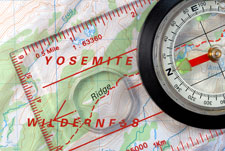
Camp, Hike, Fish
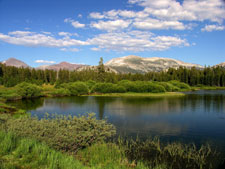
Tuolumne Meadows - Gateway To The High Country
Bill Berry's Prints Return

Yosemite's Bears
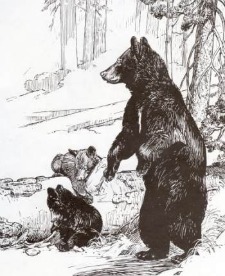
What To See In Yosemite
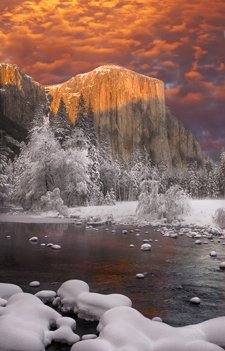
Don't Miss These Scenic Wonders
Camp And Hike Along The Old Stage Route
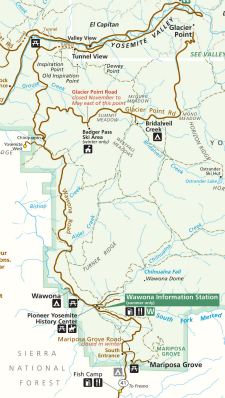
Follow The Historic Wawona Stage Route To Yosemite
See The Big Trees
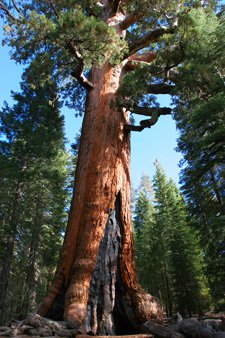
The High Sierra Camps
